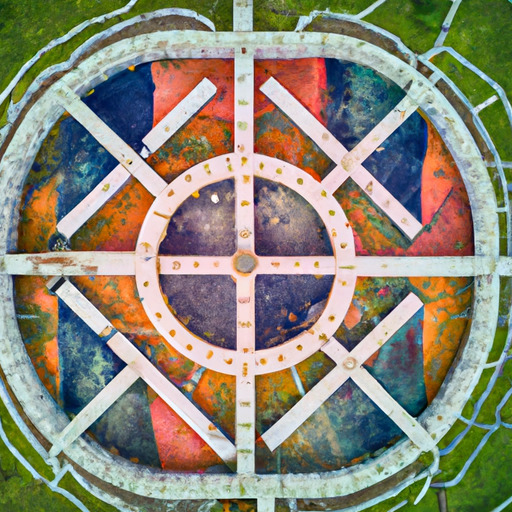Imagine a world where wastewater treatment is more than just a necessary process, but a source of inspiration and beauty. In recent years, there has been a growing recognition of the role that art can play in wastewater treatment facilities. From murals and sculptures to interactive installations, incorporating art into these facilities not only enhances aesthetic appeal but also serves as a means of educational outreach and community engagement. In this article, we will explore how the integration of art in wastewater treatment is transforming these necessary infrastructures into vibrant and interactive spaces that promote environmental consciousness and social connection.
The Role of Art in Wastewater Treatment
Introduction to Wastewater Treatment
Wastewater treatment is an essential process that ensures the safe and efficient removal of pollutants from water sources before their return to the environment. It plays a crucial role in maintaining the health of ecosystems and the well-being of communities. While the focus of wastewater treatment has traditionally been on the scientific and engineering aspects, there is an emerging recognition of the potential of art to enhance and complement this process.
The Importance of Wastewater Treatment
The importance of wastewater treatment cannot be overstated. Without proper treatment, wastewater can pose significant risks to public health, contaminate water sources, and harm aquatic ecosystems. By removing contaminants such as organic matter, nutrients, and harmful pathogens, wastewater treatment plants ensure the water released back into the environment is safe for human consumption and supports healthy aquatic life. This vital process directly contributes to the well-being and sustainability of communities worldwide.
The Potential of Art in Wastewater Treatment Processes
Art has the potential to enhance various aspects of wastewater treatment processes. From conceptualizing innovative solutions to fostering public engagement, art can offer a unique perspective and contribute to the efficiency and effectiveness of wastewater treatment. By involving artists in the design and implementation of wastewater treatment projects, new ideas and approaches can be explored, pushing the boundaries of creativity and problem-solving.
Artistic Representations of Wastewater Treatment
Artistic representations of wastewater treatment can raise awareness and provoke thought about the importance of this process. Through visual mediums such as paintings, sculptures, and photography, artists can depict the intricate systems and mechanisms involved in wastewater treatment. These representations can help the general public understand the complexity and significance of the process, fostering appreciation and support for wastewater treatment initiatives.
Awareness and Education through Art
Art has a powerful ability to communicate complex ideas and messages in an accessible and engaging manner. By incorporating art into educational programs and public campaigns, awareness about the importance of wastewater treatment can be effectively raised. Art exhibits, installations, and interactive experiences can educate the public about the impacts of untreated wastewater and encourage responsible water usage practices, ultimately contributing to the preservation of water resources.
Artistic Designs for Wastewater Treatment Facilities
Artistic designs for wastewater treatment facilities can transform these spaces from utilitarian structures to visually appealing and inspiring landmarks. An aesthetically pleasing treatment facility not only improves the visual appeal of the surrounding area but also enhances community pride and engagement. By integrating artistic elements into the architectural design, treatment facilities can become iconic symbols of the importance of environmental stewardship and sustainable development.
Artistic Integration in the Wastewater Treatment Process
Artistic integration in the wastewater treatment process can extend beyond aesthetics. Artists and scientists can collaborate to explore innovative ways to incorporate art into the treatment technologies themselves. For example, artworks can be created using materials derived from wastewater treatment processes, blurring the boundaries between art and science and highlighting the interconnectedness of human activities and the environment. This integration can inspire creative problem-solving and promote sustainable practices.
The Therapeutic Effects of Art in Wastewater Treatment
The therapeutic effects of art can have a profound impact on the well-being of individuals involved in wastewater treatment. The nature of the work in treatment plants can be physically and emotionally challenging. By incorporating art workshops or installations within the facilities, a therapeutic and calming environment can be created, promoting mental well-being and reducing stress levels. Art can serve as an outlet for self-expression and creativity, providing an escape from the demanding nature of the work.
Community Engagement and Art in Wastewater Treatment
Art can be a powerful tool for community engagement in wastewater treatment initiatives. Through participatory art projects and community-led collaborations, the public can actively contribute to the design and implementation of wastewater treatment plans. By involving the community in art installations or murals, a sense of ownership and pride can be fostered, encouraging community members to take an active role in maintaining and protecting their water resources.
Challenges and Considerations in Artistic Integration in Wastewater Treatment
While the integration of art in wastewater treatment offers immense potential, there are several challenges and considerations that need to be addressed. Funding for artistic initiatives, securing the support and involvement of artists, and potential conflicts between artistic visions and technical requirements are some of the challenges that may arise. Additionally, ensuring the long-term sustainability and maintenance of artistic elements can be a concern. These challenges require careful planning and collaboration between artists, scientists, engineers, and community stakeholders.
Conclusion
Art has the power to transform wastewater treatment processes from mere technicalities to holistic and engaging endeavors. Through its potential to raise awareness, educate, and inspire, art can complement the scientific and engineering aspects of wastewater treatment, enhancing its effectiveness and promoting community engagement. By recognizing and embracing the role of art in wastewater treatment, we can create a more sustainable and visually captivating future for our water resources and communities.



